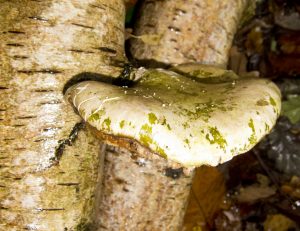Fungi and symbiotic associations, and a Woodlands TV film.

The Fungi are a very diverse and ‘strange’ group of organisms, the true fungi are referred to as the Mycota. The Oomycota are fungus-like organisms, but somewhat different and are responsible for diseases like potato blight.
Unlike green plants, fungi do not have any chlorophyll so cannot make sugars and other compounds by photosynthesis. They get their sugars / carbohydrates through being
- saprobes (saprophytes),
- parasites, or sometimes
- symbionts.
Many soil fungi are saprobes, that is, they ‘feed’ on the dead leaves, bits of bark, dead bodies of insects and other animals that end up in the soil. Fungal saprobes, together with bacteria and other organisms, use enzymes to break down the complex chemicals in the dead and decaying remains, to release simpler compounds such as sugars and amino acids. These are then used for the growth and development of the fungi.
Fungal parasites obtain their sugars and amino acids by feeding on another living organism (the host). Examples of parasitic fungi include
- mildews,
- ergot of rye,
- Athlete’s foot
- bracket fungi,
- Aspergillosis (lung disease)
- ‘rusts’ on wheat and hollyhocks
- Thrush
As can be seen from the list above, the host can be us. By definition, parasitic associations do not benefit the host.
Some fungi enter into an association with another living organism in which both partners benefit; this is symbiosis. Lichens are examples of symbiotic associations between various types of algae and fungi. For more information on the nature of lichens, see the WoodlandsTV film.
Mycorrhizae are symbiotic associations between fungi and the roots of certain trees and other plants. The microscopic, tube-like fungal threads (hyphae) form a network around the roots of a tree. They take various carbohydrate compounds from the tree that it has made through photosynthesis. However, the transfer is not one way; the tree benefits as it gains mineral nutrients from the extensive fungal network of hyphae that ramify through the soil – absorbing a variety of minerals. As a result of their enhanced mineral nutrition, mycorrhizal plants often show better growth and development when compared to non-mycorrhizal ones (of the same species).
Interestingly, it is thought that the invasive Rhododendron ponticum gains an advantage though it’s mycorrhizal associations. In nutrient poor acidic soils they may ‘starve’ competing plants of vital nutrient requirements. It also has the ability to poison the soil for others (a phenomenon known as allelopathy}. It is thought that ancient / veteran trees such as Oak in the UK, or the Bristlecones in the States have well developed and diverse mycorrhizal systems. At the other end of scale in terms of size are orchids. Orchids produce seeds that are so small [(0.35mm to 1.50mm long] that they contain no nutrition to sustain the germinating seedling. Instead, the seeds must gain the energy to grow from a fungal symbiont. The cells of the seed are actually penetrated by the fungus. Recent research on the common spotted orchid by Professor Field at the University of Sheffield suggests that the fungi supplying the nutrients may be connected to parent plants. This may explain why orchids are often found in clumps - despite the seeds being wind dispersed.
The idea that mycelial networks may allow communication between trees over a large area has received much attention recently - the wood wide web. The book “Finding the mother tree” by Suzanne Simard “proposed that trees help each other out by dispatching resources and warning signals through fungal networks in the soil”. The idea was further promulgated in a TED talk. However, a review of relevant research papers / literature by Justine Karst, University of Alberta (and others) suggests that the claims are based on limited evidence and that further research is needed.
Vanilla is made from the fermented fruits (‘pods’) of the vanilla orchid (Vanilla planifolia).
Comments are closed for this post.
